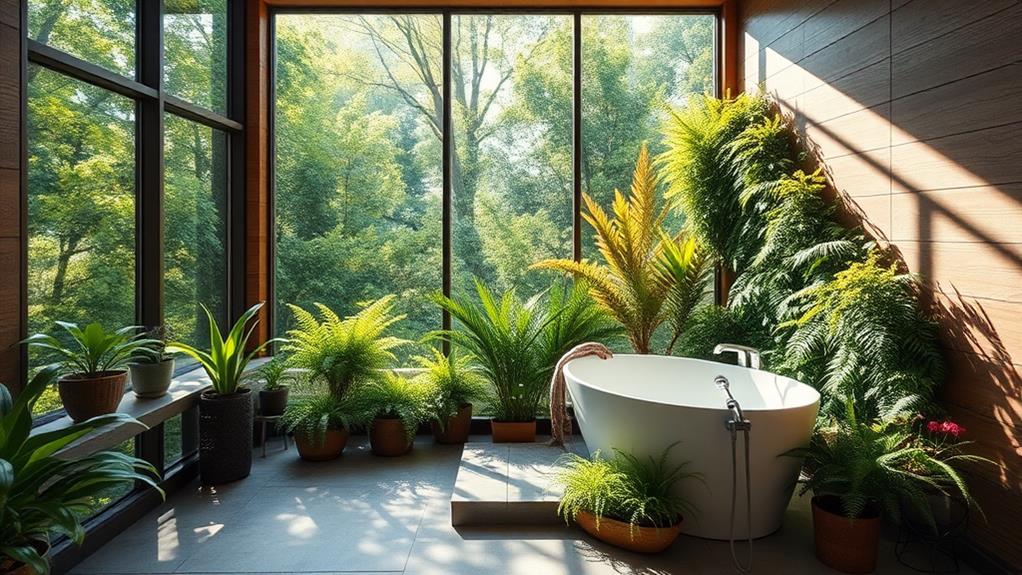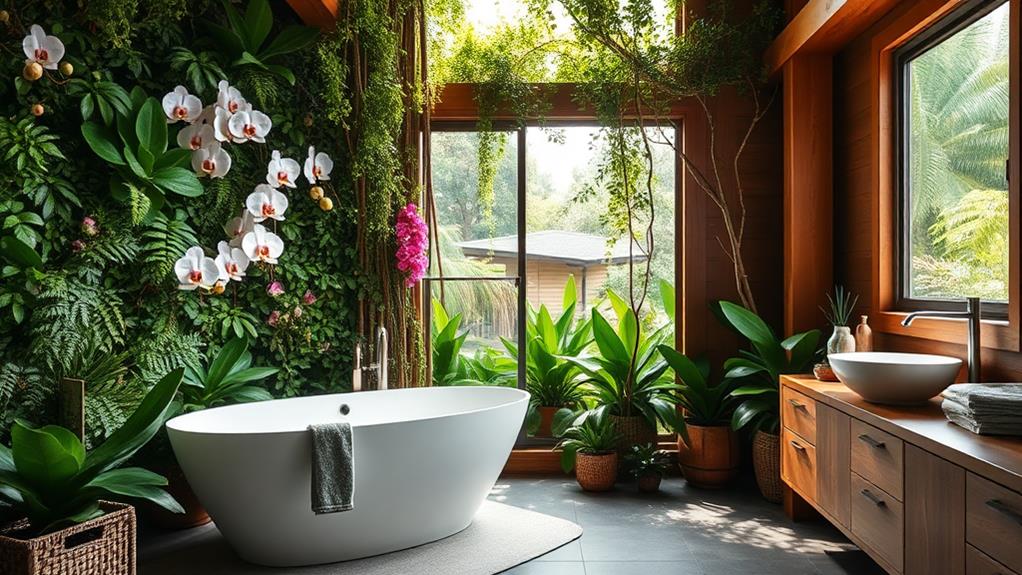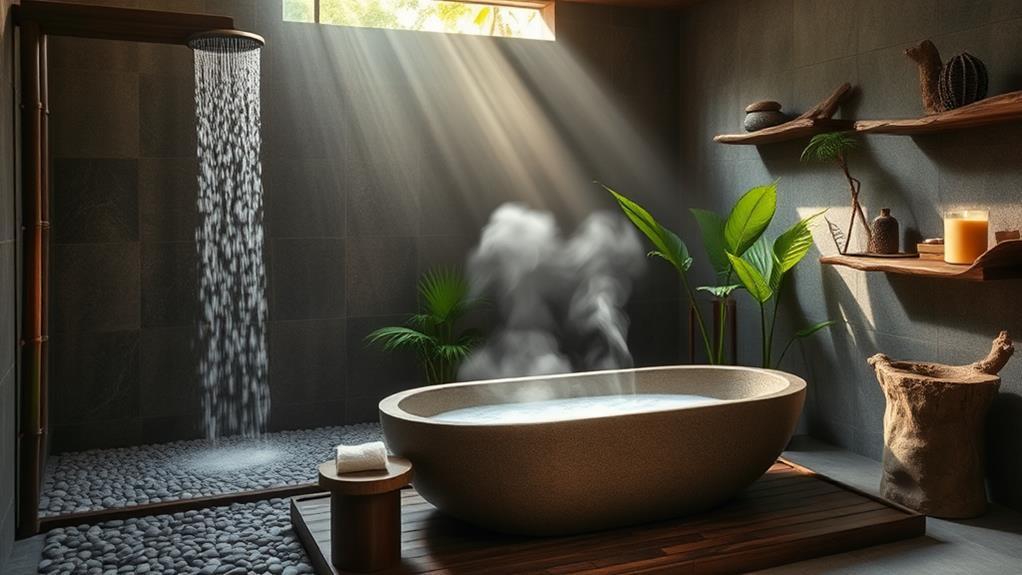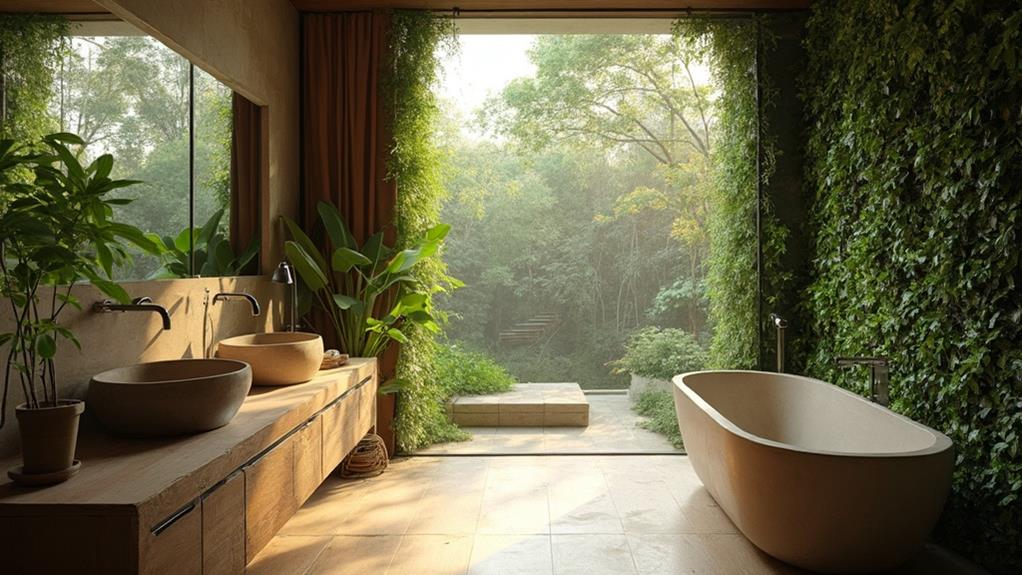Incorporating biophilic design in your bathroom remodel can create a serene, nature-inspired sanctuary. Start by choosing natural materials like water-resistant wood, stone, or bamboo for surfaces. Introduce plants that thrive in humid environments, or consider a low-maintenance living wall. Maximize natural light with larger windows, skylights, or strategically placed mirrors. Add water features like rain showerheads or wall-mounted fountains for a soothing sensory experience. Don't forget to explore indirect nature connections through organic patterns and textures in tiles or wallpaper. By embracing these principles, you'll transform your bathroom into a rejuvenating space that connects you with nature. Discover how each element can enhance your daily routine and overall well-being.
Understanding Biophilic Design Principles

Embracing the natural world, biophilic design principles bring the outdoors into your bathroom space. This design philosophy aims to connect humans with nature, enhancing well-being and reducing stress. To incorporate biophilic elements, you'll need to understand its core principles.
First, focus on direct nature experiences. This includes using natural materials like wood and stone, introducing plants, and maximizing natural light. Consider installing a skylight or larger windows to let sunshine flood your bathroom.
Next, explore indirect nature experiences. These involve natural patterns, textures, and colors that mimic nature. Think about using leaf-patterned tiles or wavy textures that resemble water.
Don't forget about human spatial responses. This principle addresses our innate preferences for certain spatial configurations. Create a sense of refuge with a cozy bathtub nook or a feeling of prospect with an open shower area. Lastly, consider natural processes like the changing of seasons or day-night cycles. You can achieve this through smart lighting systems that adjust throughout the day or by using materials that age beautifully over time, like copper fixtures that develop a patina.
Natural Materials for Bathroom Surfaces
Natural materials are essential in bringing biophilic design into your bathroom. When selecting surfaces, opt for materials that evoke a connection to nature. Consider using wood for vanities or shelving, as it adds warmth and texture. Choose water-resistant varieties like teak or cedar for durability.
Stone is another excellent choice for bathroom surfaces. Granite, marble, or slate can be used for countertops, shower walls, or flooring. These materials not only look beautiful but also provide a tactile experience that mimics nature. For a softer touch, consider limestone or travertine.
Don't overlook the power of bamboo. It's sustainable, water-resistant, and can be used for flooring or decorative elements. Cork is another eco-friendly option that's naturally antimicrobial and comfortable underfoot.
For a unique twist, incorporate river rocks into your shower floor or as a backsplash. They provide a massage-like sensation and create a visually striking element. Lastly, consider using natural clay tiles, which come in various earthy tones and textures, perfect for achieving a biophilic aesthetic in your bathroom remodel.
Incorporating Plants and Living Walls

While natural materials set the stage for a biophilic bathroom, plants breathe life into the space. You can incorporate greenery in various ways, from small potted plants to expansive living walls. Start by selecting moisture-loving plants that thrive in humid environments, such as ferns, orchids, or air plants. Place them on shelves, windowsills, or hang them from the ceiling to add vertical interest.
For a bolder statement, consider installing a living wall. This vertical garden not only serves as a stunning focal point but also improves air quality and humidity levels. You'll need to plan for proper lighting, irrigation, and drainage systems to maintain your living wall. If you're short on space or concerned about maintenance, opt for low-maintenance options like preserved moss walls or artificial plant panels.
Don't forget to integrate plants into your shower area. Hang a teak shower caddy with built-in planters or install a waterproof planter niche in your shower wall. These additions will create a spa-like atmosphere and connect you with nature during your daily routine. Remember to choose plants that can withstand occasional splashes and maintain proper ventilation to prevent mold growth.
Maximizing Natural Light Sources
Nearly every bathroom can benefit from increased natural light. To maximize natural light sources in your bathroom, start by assessing your current windows. If possible, enlarge existing windows or add new ones to bring in more sunlight. Consider installing skylights or solar tubes, which can flood your space with natural light from above.
Choose window treatments that allow light to filter through while maintaining privacy. Frosted glass, translucent shades, or bottom-up blinds are excellent options. Mirrors strategically placed opposite windows can amplify natural light, making your bathroom feel brighter and more spacious.
When selecting paint colors, opt for light, reflective hues that bounce light around the room. Glossy finishes on tiles and fixtures can also help distribute light more effectively. If your bathroom lacks windows, consider using light fixtures that mimic natural sunlight, such as full-spectrum bulbs or smart lighting systems that adjust color temperature throughout the day.
Don't forget about the exterior of your home. Trim back any overgrown vegetation that may be blocking sunlight from entering your bathroom windows. By maximizing natural light, you'll create a more inviting, energy-efficient, and biophilic bathroom space.
Water Features for Sensory Experience

Moving beyond visual elements, water features can transform your bathroom into a multi-sensory oasis. They engage your hearing and touch, creating a calming atmosphere that mimics nature. Consider installing a wall-mounted waterfall feature, which can serve as a stunning focal point while providing soothing ambient sounds.
For a more subtle approach, opt for a small tabletop fountain that can be placed on a vanity or windowsill.
If you're looking for a more immersive experience, explore rain showerheads or body jets in your shower enclosure. These features not only enhance your bathing routine but also create a spa-like environment in your own home. For a luxurious touch, consider a freestanding soaking tub with a built-in water feature, such as a cascading faucet or bubble jets.
When incorporating water features, ensure proper waterproofing and drainage to prevent moisture damage. Choose materials that can withstand constant exposure to water, such as natural stone or ceramic tiles. Don't forget to consider the acoustics of your bathroom; softer surfaces can help absorb sound and create a more serene atmosphere. By thoughtfully integrating water features, you'll create a biophilic bathroom that engages all your senses.
Conclusion
As you embark on your bathroom remodel, let biophilic design be your compass, guiding you toward a space that nurtures your connection with nature. By embracing natural materials, living plants, ample daylight, and soothing water features, you're not just creating a bathroom; you're cultivating an oasis. Remember, every element you choose is a brushstroke in your personal masterpiece of wellness. So go ahead, paint your bathroom with nature's palette and watch it bloom.

